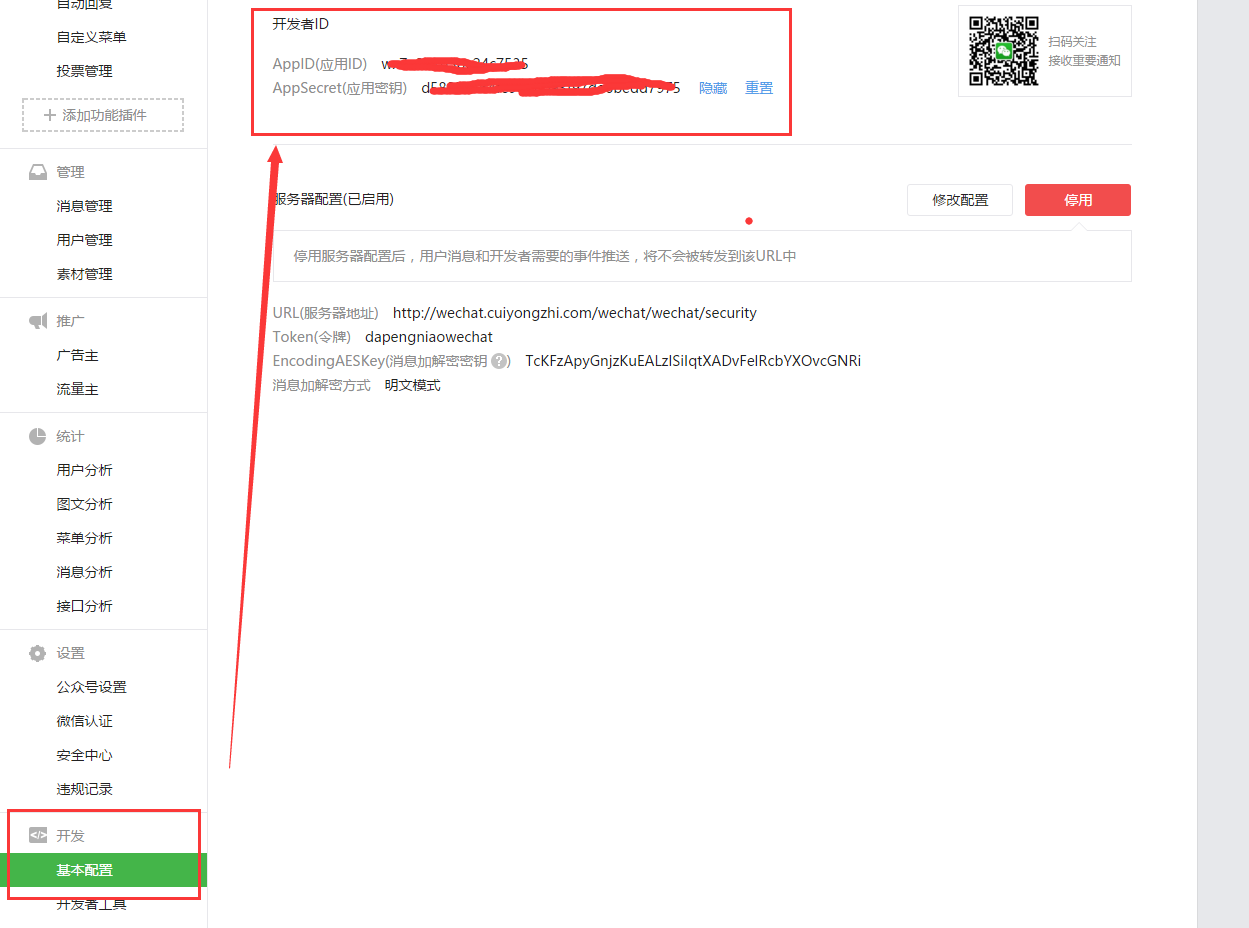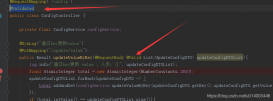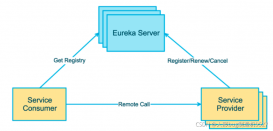(一)token的介绍
引用:access_token是公众号的全局唯一票据,公众号调用各接口时都需使用access_token。开发者需要进行妥善保存。access_token的存储至少要保留512个字符空间。access_token的有效期目前为2个小时,需定时刷新,重复获取将导致上次获取的access_token失效!
(二)token的获取参考文档
获取的流程我们完全可以参考微信官方文档:http://mp.weixin.qq.com/wiki/14/9f9c82c1af308e3b14ba9b973f99a8ba.html 如图:

(三)token获取流程分析
从公众平台获取账号的AppID和AppSecret;
token获取并解析存储执行体;
采用任务调度每隔两小时执行一次token获取执行体;
(四)token的获取流程的具体实现
①获取appid和appsecret
在微信公众平台【开发】——>【基本配置】中可以查看到我们需要的两个参数:

这里我们将他们定义到我们的配置文件【wechat.properties】中,大致代码为:
|
1
2
3
4
|
#获取到的appidappid=wx7e32765bc24XXXX #获取到的AppSecretAppSecret=d58051564fe9d86093f9XXXXX |
②token获取并解析存储执行体的代码编写
由于在这里我们需要通过http的get请求向微信服务器获取时效性为7200秒的token,所以我在这里写了一个http请求的工具类,以方便我们的使用,如下:
|
1
2
3
4
5
6
7
8
9
10
11
12
13
14
15
16
17
18
19
20
21
22
23
24
25
26
27
28
29
30
31
32
33
34
35
36
37
38
39
40
41
42
43
44
45
46
47
48
49
50
51
52
53
54
55
56
57
58
59
60
61
62
63
64
65
66
67
68
69
70
71
72
73
74
75
76
77
78
79
80
81
82
83
84
85
86
87
88
89
90
91
92
93
94
95
96
97
98
99
100
101
102
103
104
105
106
107
108
109
110
111
112
113
114
115
116
117
118
119
120
121
122
123
124
125
126
127
128
129
130
131
132
133
134
135
136
137
138
139
140
141
142
143
144
145
146
147
148
149
150
151
152
153
154
155
156
157
158
159
160
161
162
163
164
165
166
167
168
169
170
171
172
173
174
175
176
177
178
179
180
181
182
183
184
185
186
187
188
189
190
191
192
193
194
195
196
197
198
199
200
201
202
203
204
205
206
207
208
209
210
211
212
213
214
215
216
217
218
219
220
221
222
223
224
225
226
227
228
229
230
231
232
233
234
235
236
237
238
239
240
241
242
243
244
245
246
247
248
249
250
|
package com.cuiyongzhi.wechat.util; import java.io.BufferedInputStream;import java.io.BufferedReader;import java.io.IOException;import java.io.InputStream;import java.io.InputStreamReader;import java.io.OutputStreamWriter;import java.net.MalformedURLException;import java.net.URI;import java.net.URL;import java.net.URLConnection;import java.util.ArrayList;import java.util.List;import java.util.Map;import java.util.Set;import java.util.zip.GZIPInputStream; import org.apache.http.HttpResponse;import org.apache.http.NameValuePair;import org.apache.http.client.ClientProtocolException;import org.apache.http.client.HttpClient;import org.apache.http.client.entity.UrlEncodedFormEntity;import org.apache.http.client.methods.HttpGet;import org.apache.http.client.methods.HttpPost;import org.apache.http.entity.StringEntity;import org.apache.http.impl.client.DefaultHttpClient;import org.apache.http.message.BasicNameValuePair;import org.apache.http.protocol.HTTP;import org.apache.http.util.EntityUtils; /** * ClassName: HttpUtils * * @Description: http请求工具类 * @author dapengniao * @date 2016年3月10日 下午3:57:14 */@SuppressWarnings("deprecation")public class HttpUtils { /** * @Description: http get请求共用方法 * @param @param reqUrl * @param @param params * @param @return * @param @throws Exception * @author dapengniao * @date 2016年3月10日 下午3:57:39 */ @SuppressWarnings("resource") public static String sendGet(String reqUrl, Map<String, String> params) throws Exception { InputStream inputStream = null; HttpGet request = new HttpGet(); try { String url = buildUrl(reqUrl, params); HttpClient client = new DefaultHttpClient(); request.setHeader("Accept-Encoding", "gzip"); request.setURI(new URI(url)); HttpResponse response = client.execute(request); inputStream = response.getEntity().getContent(); String result = getJsonStringFromGZIP(inputStream); return result; } finally { if (inputStream != null) { inputStream.close(); } request.releaseConnection(); } } /** * @Description: http post请求共用方法 * @param @param reqUrl * @param @param params * @param @return * @param @throws Exception * @author dapengniao * @date 2016年3月10日 下午3:57:53 */ @SuppressWarnings("resource") public static String sendPost(String reqUrl, Map<String, String> params) throws Exception { try { Set<String> set = params.keySet(); List<NameValuePair> list = new ArrayList<NameValuePair>(); for (String key : set) { list.add(new BasicNameValuePair(key, params.get(key))); } if (list.size() > 0) { try { HttpClient client = new DefaultHttpClient(); HttpPost request = new HttpPost(reqUrl); request.setHeader("Accept-Encoding", "gzip"); request.setEntity(new UrlEncodedFormEntity(list, HTTP.UTF_8)); HttpResponse response = client.execute(request); InputStream inputStream = response.getEntity().getContent(); try { String result = getJsonStringFromGZIP(inputStream); return result; } finally { inputStream.close(); } } catch (Exception ex) { ex.printStackTrace(); throw new Exception("网络连接失败,请连接网络后再试"); } } else { throw new Exception("参数不全,请稍后重试"); } } catch (Exception ex) { ex.printStackTrace(); throw new Exception("发送未知异常"); } } /** * @Description: http post请求json数据 * @param @param urls * @param @param params * @param @return * @param @throws ClientProtocolException * @param @throws IOException * @author dapengniao * @date 2016年3月10日 下午3:58:15 */ public static String sendPostBuffer(String urls, String params) throws ClientProtocolException, IOException { HttpPost request = new HttpPost(urls); StringEntity se = new StringEntity(params, HTTP.UTF_8); request.setEntity(se); // 发送请求 @SuppressWarnings("resource") HttpResponse httpResponse = new DefaultHttpClient().execute(request); // 得到应答的字符串,这也是一个 JSON 格式保存的数据 String retSrc = EntityUtils.toString(httpResponse.getEntity()); request.releaseConnection(); return retSrc; } /** * @Description: http请求发送xml内容 * @param @param urlStr * @param @param xmlInfo * @param @return * @author dapengniao * @date 2016年3月10日 下午3:58:32 */ public static String sendXmlPost(String urlStr, String xmlInfo) { // xmlInfo xml具体字符串 try { URL url = new URL(urlStr); URLConnection con = url.openConnection(); con.setDoOutput(true); con.setRequestProperty("Pragma:", "no-cache"); con.setRequestProperty("Cache-Control", "no-cache"); con.setRequestProperty("Content-Type", "text/xml"); OutputStreamWriter out = new OutputStreamWriter( con.getOutputStream()); out.write(new String(xmlInfo.getBytes("utf-8"))); out.flush(); out.close(); BufferedReader br = new BufferedReader(new InputStreamReader( con.getInputStream())); String lines = ""; for (String line = br.readLine(); line != null; line = br .readLine()) { lines = lines + line; } return lines; // 返回请求结果 } catch (MalformedURLException e) { e.printStackTrace(); } catch (IOException e) { e.printStackTrace(); } return "fail"; } private static String getJsonStringFromGZIP(InputStream is) { String jsonString = null; try { BufferedInputStream bis = new BufferedInputStream(is); bis.mark(2); // 取前两个字节 byte[] header = new byte[2]; int result = bis.read(header); // reset输入流到开始位置 bis.reset(); // 判断是否是GZIP格式 int headerData = getShort(header); // Gzip 流 的前两个字节是 0x1f8b if (result != -1 && headerData == 0x1f8b) { // LogUtil.i("HttpTask", " use GZIPInputStream "); is = new GZIPInputStream(bis); } else { // LogUtil.d("HttpTask", " not use GZIPInputStream"); is = bis; } InputStreamReader reader = new InputStreamReader(is, "utf-8"); char[] data = new char[100]; int readSize; StringBuffer sb = new StringBuffer(); while ((readSize = reader.read(data)) > 0) { sb.append(data, 0, readSize); } jsonString = sb.toString(); bis.close(); reader.close(); } catch (Exception e) { e.printStackTrace(); } return jsonString; } private static int getShort(byte[] data) { return (data[0] << 8) | data[1] & 0xFF; } /** * 构建get方式的url * * @param reqUrl * 基础的url地址 * @param params * 查询参数 * @return 构建好的url */ public static String buildUrl(String reqUrl, Map<String, String> params) { StringBuilder query = new StringBuilder(); Set<String> set = params.keySet(); for (String key : set) { query.append(String.format("%s=%s&", key, params.get(key))); } return reqUrl + "?" + query.toString(); } } |
我们在做http请求的时候需要目标服务器的url,这里在项目中为了方便对url的管理我们在资源目录下建立了interface_url.properties用于存放目标url,这里我们将请求token的url存入:
|
1
2
|
#获取token的urltokenUrl=https://api.weixin.qq.com/cgi-bin/token |
我们需要将我们配置的配置文件在项目初始化后能得到启动,所以我在这里加入一个项目初始化的代码实现,用于项目启动初始化interface_url.properties和wechat.properties中的配置:
|
1
2
3
4
5
6
7
8
9
10
11
12
13
14
15
16
17
18
19
20
21
22
|
package com.cuiyongzhi.web.start; import javax.servlet.ServletConfig;import javax.servlet.ServletException;import javax.servlet.http.HttpServlet; /** * ClassName: InterfaceUrlIntiServlet * @Description: 项目启动初始化servlet * @author dapengniao * @date 2016年3月10日 下午4:08:43 */public class InterfaceUrlIntiServlet extends HttpServlet { private static final long serialVersionUID = 1L; @Override public void init(ServletConfig config) throws ServletException { InterfaceUrlInti.init(); } } |
初始化的具体实现,将初始化过后的方法都存入到GlobalConstants中方便项目中随意调用,如下:
|
1
2
3
4
5
6
7
8
9
10
11
12
13
14
15
16
17
18
19
20
21
22
23
24
25
26
27
28
29
30
31
32
33
34
35
36
37
38
39
40
41
42
43
44
45
46
47
48
49
50
51
52
|
package com.cuiyongzhi.web.start; import java.io.IOException;import java.io.InputStream;import java.util.Properties; import com.cuiyongzhi.web.util.GlobalConstants; /** * ClassName: InterfaceUrlInti * @Description: 项目启动初始化方法 * @author dapengniao * @date 2016年3月10日 下午4:08:21 */public class InterfaceUrlInti { public synchronized static void init(){ ClassLoader cl = Thread.currentThread().getContextClassLoader(); Properties props = new Properties(); if(GlobalConstants.interfaceUrlProperties==null){ GlobalConstants.interfaceUrlProperties = new Properties(); } InputStream in = null; try { in = cl.getResourceAsStream("interface_url.properties"); props.load(in); for(Object key : props.keySet()){ GlobalConstants.interfaceUrlProperties.put(key, props.get(key)); } props = new Properties(); in = cl.getResourceAsStream("wechat.properties"); props.load(in); for(Object key : props.keySet()){ GlobalConstants.interfaceUrlProperties.put(key, props.get(key)); } } catch (IOException e) { e.printStackTrace(); }finally{ if(in!=null){ try { in.close(); } catch (IOException e) { e.printStackTrace(); } } } return; } } |
当我们把所有的准备工作都做好了之后我们可以开始真正的去获取token了,这里我们将获取到的token解析之后依然存储到GlobalConstants中方便使用,简单代码如下:
|
1
2
3
4
5
6
7
8
9
10
11
12
13
14
15
16
17
18
19
20
21
22
23
24
25
26
27
28
29
30
31
32
33
34
35
36
37
|
package com.cuiyongzhi.wechat.common; import java.util.HashMap;import java.util.Map; import net.sf.json.JSONObject; import com.cuiyongzhi.web.util.GlobalConstants;import com.cuiyongzhi.wechat.util.HttpUtils; /** * ClassName: WeChatTask * @Description: 微信两小时定时任务体 * @author dapengniao * @date 2016年3月10日 下午1:42:29 */public class WeChatTask { /** * @Description: 任务执行体 * @param @throws Exception * @author dapengniao * @date 2016年3月10日 下午2:04:37 */ public void getToken_getTicket() throws Exception { Map<String, String> params = new HashMap<String, String>(); params.put("grant_type", "client_credential"); params.put("appid", GlobalConstants.getInterfaceUrl("appid")); params.put("secret", GlobalConstants.getInterfaceUrl("AppSecret")); String jstoken = HttpUtils.sendGet( GlobalConstants.getInterfaceUrl("tokenUrl"), params); String access_token = JSONObject.fromObject(jstoken).getString( "access_token"); // 获取到token并赋值保存 GlobalConstants.interfaceUrlProperties.put("access_token", access_token); System.out.println(new SimpleDateFormat("yyyy-MM-dd HH:mm:ss").format(new Date())+"token为=============================="+access_token); } } |
(三)采用任务调度每隔两小时执行一次token获取执行体
我们阅读过微信的文档会发现我们的token获取的接口每天是有调用次数限制的,为了防止我们业务量比较大的情况下token的直接调用的接口次数不够用,所以我们需要根据token的时效性(7200s)在自己的业务服务器上做到token的缓存并定时获取,我这里用到的任务调度的方式是采用quartz,有关quartz的使用可以参考文章 http://cuiyongzhi.com/?tags=%E5%AE%9A%E6%97%B6%E4%BB%BB%E5%8A%A1 ,下面具体代码的实现:
|
1
2
3
4
5
6
7
8
9
10
11
12
13
14
15
16
17
18
19
20
21
22
23
24
25
|
package com.cuiyongzhi.wechat.quartz; import org.apache.log4j.Logger; import com.cuiyongzhi.wechat.common.WeChatTask; public class QuartzJob{ private static Logger logger = Logger.getLogger(QuartzJob.class); /** * @Description: 任务执行获取token * @param * @author dapengniao * @date 2016年3月10日 下午4:34:26 */ public void workForToken() { try { WeChatTask timer = new WeChatTask(); timer.getToken_getTicket(); } catch (Exception e) { logger.error(e, e); } } } |
这里新建配置文件spring-quartz.xml以方便quartz任务的管理和启用,这里将我们需要用到的workForToken()加入到执行任务中:
|
1
2
3
4
5
6
7
8
9
10
11
12
13
14
15
16
17
18
19
20
21
22
23
24
25
26
27
28
29
30
31
32
33
34
35
36
37
38
39
40
41
42
43
|
<?xml version="1.0" encoding="UTF-8"?><!DOCTYPE beans PUBLIC "-//SPRING//DTD BEAN//EN" "http://www.springframework.org/dtd/spring-beans.dtd"> <beans> <!-- 要调用的工作类 --> <bean id="quartzJob" class="com.cuiyongzhi.wechat.quartz.QuartzJob"></bean> <!-- 定义调用对象和调用对象的方法 --> <bean id="jobtaskForToken" class="org.springframework.scheduling.quartz.MethodInvokingJobDetailFactoryBean"> <!-- 调用的类 --> <property name="targetObject"> <ref bean="quartzJob" /> </property> <!-- 调用类中的方法 --> <property name="targetMethod"> <value>workForToken</value> </property> </bean> <!-- 定义触发时间 --> <bean id="doTimeForToken" class="org.springframework.scheduling.quartz.CronTriggerBean"> <property name="jobDetail"> <ref bean="jobtaskForToken" /> </property> <!-- cron表达式 --> <property name="cronExpression"> <value>0 0/1 * * * ?</value> </property> </bean> <!-- 总管理类 如果将lazy-init='false'那么容器启动就会执行调度程序 --> <bean id="startQuertz" lazy-init="false" autowire="no" class="org.springframework.scheduling.quartz.SchedulerFactoryBean"> <property name="triggers"> <list> <ref bean="doTimeForToken" /> </list> </property> </bean> </beans> |
这里我为了测试将执行间隔时间设置成了1分钟一次,根据需要可以自行修改执行时间;最后我们需要在我们的web.xml启动项中开启quartz的使用:
|
1
2
3
4
5
|
<context-param> <param-name>contextConfigLocation</param-name> <param-value>classpath:spring.xml,classpath:spring-mybatis.xml,classpath:spring-quartz.xml</param-value> <!-- ,classpath:spring-quartz.xml 用于做任务调度 任务定时都可以 --> </context-param> |
当这一切都准备完毕之后我们启动项目,会发现每间隔一分钟就会有token获取到,这里我是将其存储在项目变量中,但是如果需要考虑到项目横向扩展这里建议将token存储到缓存中;运行结果如下:

那么到这里token的获取和保存就基本讲完了,下一篇将讲述【多媒体消息的回复】,感谢你的翻阅,如果有需要源码或有疑问可以留言!
以上就是本文的全部内容,希望对大家的学习有所帮助,也希望大家多多支持服务器之家。
原文链接:http://www.cuiyongzhi.com/post/44.html















